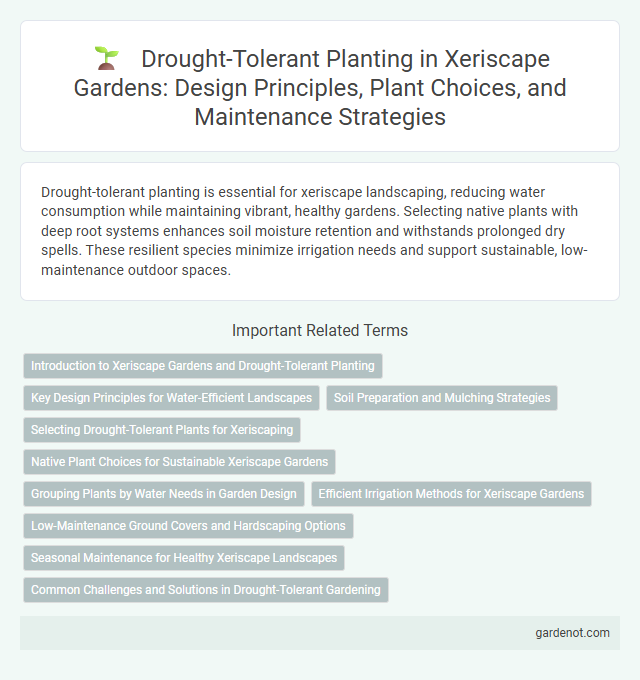Drought-tolerant planting is essential for xeriscape landscaping, reducing water consumption while maintaining vibrant, healthy gardens. Selecting native plants with deep root systems enhances soil moisture retention and withstands prolonged dry spells. These resilient species minimize irrigation needs and support sustainable, low-maintenance outdoor spaces.
Introduction to Xeriscape Gardens and Drought-Tolerant Planting
Xeriscape gardens utilize drought-tolerant plants such as succulents, native grasses, and Mediterranean herbs to minimize water usage while maintaining aesthetic appeal. These plants have adapted to thrive in arid climates by storing water in their leaves, reducing evapotranspiration, and developing deep root systems. Implementing drought-resistant species in landscaping significantly conserves water resources and supports sustainable gardening practices.
Key Design Principles for Water-Efficient Landscapes
Drought-tolerant planting emphasizes selecting native and adapted species that require minimal irrigation, conserving water efficiently in xeriscape design. Key design principles include grouping plants with similar water needs, improving soil with organic matter to enhance moisture retention, and using mulch to reduce evaporation and suppress weeds. These strategies collectively optimize water use, promote plant health, and create sustainable, low-maintenance landscapes ideal for arid climates.
Soil Preparation and Mulching Strategies
Effective soil preparation for drought-tolerant planting in xeriscape involves incorporating organic matter and ensuring well-drained, aerated soil to promote deep root growth and moisture retention. Applying a thick layer of mulch, such as wood chips or gravel, reduces evaporation, regulates soil temperature, and suppresses weed growth. These mulching strategies enhance water efficiency and support sustainable xeriscape landscapes in arid environments.
Selecting Drought-Tolerant Plants for Xeriscaping
Selecting drought-tolerant plants for xeriscaping involves choosing species like succulents, agave, lavender, and native grasses that thrive with minimal water. These plants have adapted to conserve moisture through features such as deep root systems, waxy leaves, and reduced leaf surface area. Incorporating diverse drought-resistant plants ensures a sustainable, low-maintenance landscape that reduces water consumption and supports local ecosystems.
Native Plant Choices for Sustainable Xeriscape Gardens
Drought-tolerant planting emphasizes native plant choices that enhance sustainability in xeriscape gardens by requiring minimal water and maintenance. Species such as Texas Sage, Blackfoot Daisy, and Desert Marigold thrive in arid conditions, promoting biodiversity while conserving resources. Integrating native plants reduces irrigation needs and supports local ecosystems, making xeriscaping both eco-friendly and cost-effective.
Grouping Plants by Water Needs in Garden Design
Grouping plants by their water needs in xeriscape garden design maximizes irrigation efficiency and conserves water resources. Clustering drought-tolerant species such as succulents, native grasses, and Mediterranean herbs reduces water waste and supports plant health by providing tailored moisture levels. Strategic plant grouping creates microclimates that enhance soil moisture retention and promote sustainable landscaping under arid conditions.
Efficient Irrigation Methods for Xeriscape Gardens
Efficient irrigation methods such as drip irrigation and soaker hoses deliver water directly to plant roots, minimizing evaporation and runoff in xeriscape gardens. These targeted watering systems support drought-tolerant plants by maintaining optimal soil moisture levels while conserving water resources. Incorporating rain sensors and smart irrigation controllers further enhances water efficiency by adjusting irrigation schedules based on real-time weather data.
Low-Maintenance Ground Covers and Hardscaping Options
Low-maintenance ground covers like creeping thyme, sedum, and buffalo grass reduce water usage and prevent soil erosion in xeriscape designs. Drought-tolerant hardscaping materials such as permeable pavers, decomposed granite, and natural stone enhance water conservation by minimizing irrigation needs. Incorporating these elements creates sustainable landscapes that thrive in arid conditions while requiring minimal upkeep.
Seasonal Maintenance for Healthy Xeriscape Landscapes
Drought-tolerant planting requires seasonal maintenance such as pruning, mulching, and monitoring soil moisture to sustain healthy xeriscape landscapes. Removing dead or diseased foliage during spring and fall enhances plant vigor and reduces water stress. Applying mulch conserves soil moisture and regulates temperature, optimizing the drought-resistant plants' growth throughout dry periods.
Common Challenges and Solutions in Drought-Tolerant Gardening
Drought-tolerant planting often faces challenges such as poor soil quality, inconsistent watering, and pest management. Solutions include amending soil with organic matter to improve moisture retention, implementing drip irrigation systems for efficient water use, and selecting native, pest-resistant drought-adapted plants. Employing mulch and proper plant spacing further enhances water conservation and plant health in xeriscape gardens.
Drought-tolerant planting Infographic

 gardenot.com
gardenot.com